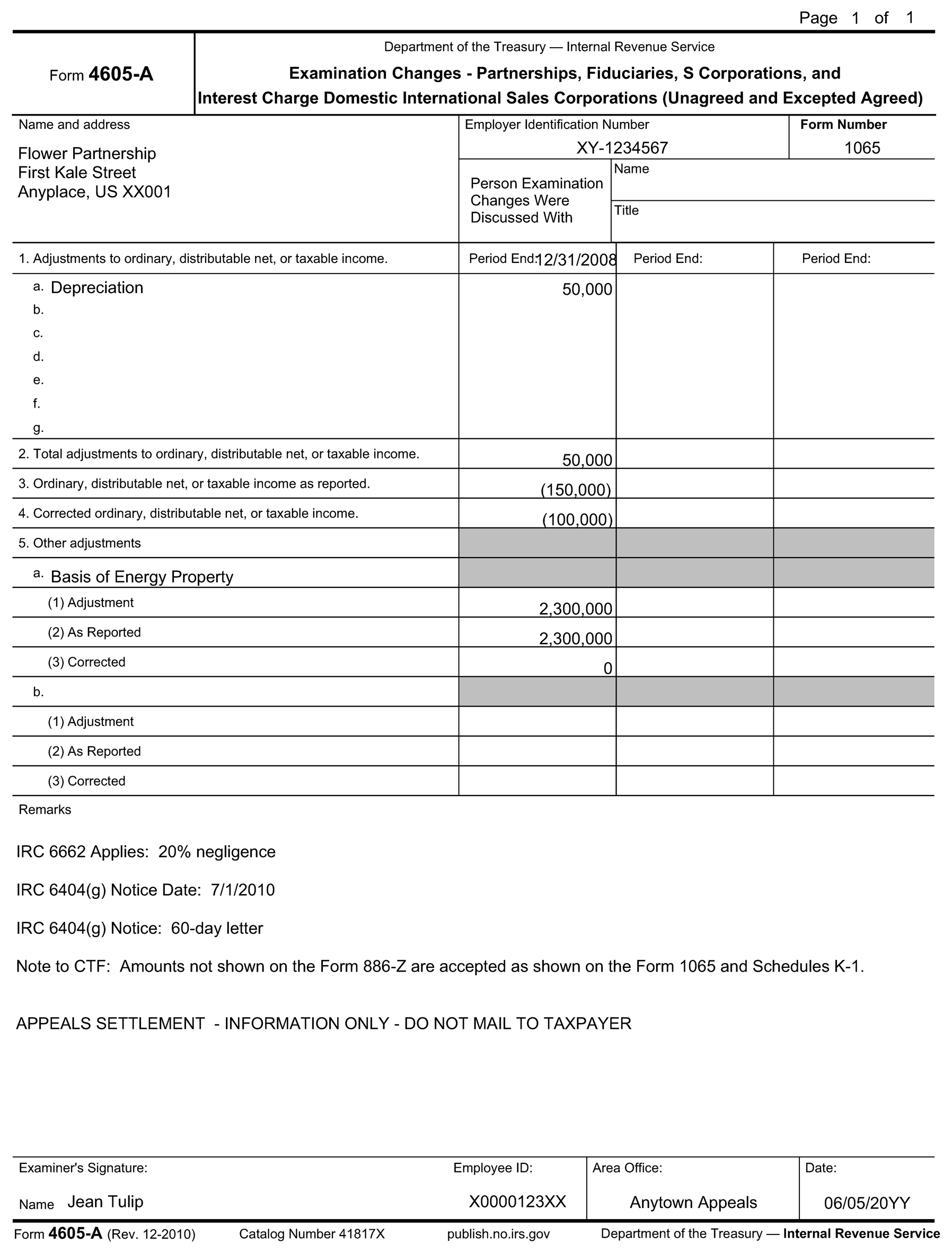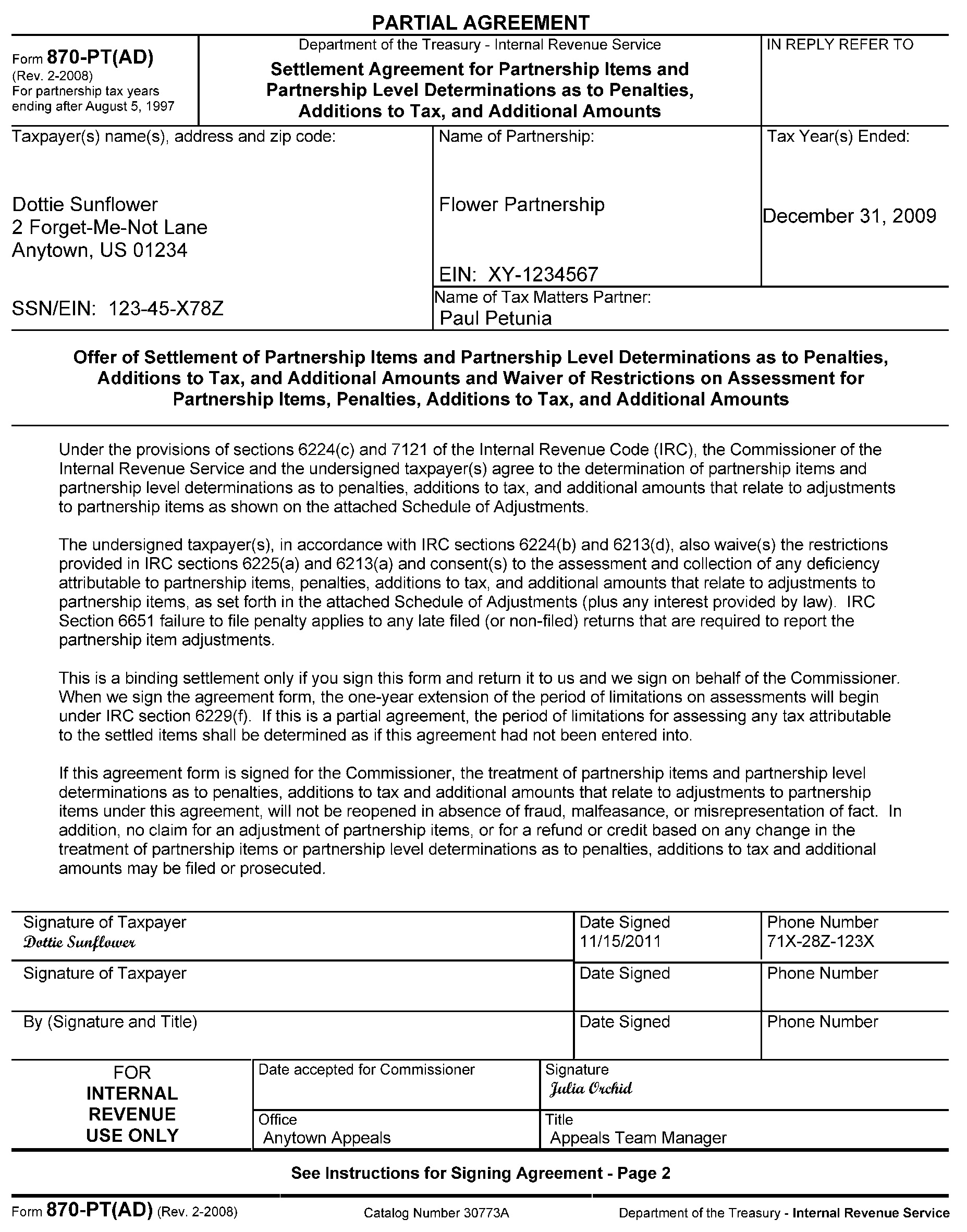- 8.19.11 Agreed TEFRA Partnership Cases
- 8.19.11.1 Program Scope and Objectives
- 8.19.11.1.1 Background
- 8.19.11.1.2 Authority
- 8.19.11.1.3 Responsibilities
- 8.19.11.1.4 Program Reports
- 8.19.11.1.5 Terms and Acronyms
- 8.19.11.1.6 Related Resources
- 8.19.11.2 Agreed TEFRA Partnership Cases
- 8.19.11.2.1 Appeals TEFRA Team (ATT)
- 8.19.11.2.2 Partnership Tax Years Ending Before August 6, 1997
- 8.19.11.3 Who Receives an Agreement Form
- 8.19.11.4 Types of Agreement Forms Used
- 8.19.11.5 Who Signs the Agreement Form for the Partner
- 8.19.11.5.1 Joint Returns
- 8.19.11.5.2 Consolidated Returns
- 8.19.11.5.3 Indirect Partners
- 8.19.11.5.4 Non-Notice Partners
- 8.19.11.5.5 Acceptance of Faxed Agreements
- 8.19.11.6 Request For Audit Work
- 8.19.11.7 Responsibilities of the Tax Computation Specialist (TCS)
- 8.19.11.8 Closing Package to the Campus TEFRA Function
- 8.19.11.9 Campus TEFRA Function (CTF) Mails Agreement Forms
- 8.19.11.9.1 Monitoring the Case
- 8.19.11.9.2 Receiving/Accepting Agreement Forms
- 8.19.11.9.3 Closing the Case
- 8.19.11.10 Appeals Office Mails Agreement Forms
- 8.19.11.10.1 Monitoring the Case
- 8.19.11.10.2 Receiving/Accepting Agreement Forms
- 8.19.11.10.3 Closing the Case
- 8.19.11.11 Agreement Forms with Penalties or Affected Items
- 8.19.11.11.1 Partnership Tax Years Ending After August 5, 1997
- 8.19.11.11.2 Who May Bind
- 8.19.11.12 Partial Agreements
- 8.19.11.13 Closing Agreements
- 8.19.11.14 No-Change Cases
- 8.19.11.14.1 Preparing the Letter 2621 and Closing Package
- 8.19.11.14.2 Closing the Case
- Exhibit 8.19.11-1 Form 4605-A
- Exhibit 8.19.11-2 Form 886-Z with Penalties and Affected Items for Partnership Tax Years Ending After August 5, 1997
- Exhibit 8.19.11-3 Allocation of Partnership Items
- Exhibit 8.19.11-4 Allocation of Partners' Ownership
- Exhibit 8.19.11-5 No-Change Settlement Schedule of Adjustments
- Exhibit 8.19.11-6 Form 3210 - CTF to Mail Settlement Offer
- Exhibit 8.19.11-7 Form 3210 - CTF to Mail No Change Settlement Offer
- Exhibit 8.19.11-8 Form 3210 - Agreement Forms Received in Appeals
- Exhibit 8.19.11-9 Form 3210 - Non-docketed Case Agreed Closing
- Exhibit 8.19.11-10 Form 886-Z with Penalties and Affected Items for Partnership Tax Years Ending After August 5, 1997- Agreed Partners
- Exhibit 8.19.11-11 Form 870-PT(AD) - Partial Agreement
- Exhibit 8.19.11-12 Form 3210 - Partial Settlement Agreement Forms
- Exhibit 8.19.11-13 Form 3210 – No Adjustments Letter
- 8.19.11.1 Program Scope and Objectives
Part 8. Appeals
Chapter 19. Appeals Pass-Through Entity Handbook
Section 11. Agreed TEFRA Partnership Cases
8.19.11 Agreed TEFRA Partnership Cases
Manual Transmittal
May 09, 2025
Purpose
(1) This transmits revised IRM 8.19.11, Agreed TEFRA Partnership Cases.
Material Changes
(1) Added new IRM section, Program Scope and Objectives, and its related subsections to comply with the Deputy Commissioner of Services and Enforcement and Operations Support memo, dated September 14, 2016, entitled Heightened Awareness, Sensitivity and Understanding of Internal Controls.IRM 8.19.11.2.1
(2) Added Taxpayer Bill of Rights (TBOR) content based on guidance from the Division Counsel/Associate Chief Counsel (National Taxpayer Advocate Program) and Branch 3 of the Associate Chief Counsel (Procedure and Administration) to the Related Resources section of the Internal Controls.
(3) Added the following statement to the Related Resources section of the Internal Controls: “In accordance with IRM 25.30.2.3, Statement of Commitment, Appeals will work collaboratively with the Taxpayer Advocate Service (TAS) to enhance the taxpayer experience. For more information, see IRM 25.30.2, Service Level Agreement between the IRS Independent Office of Appeals and the Taxpayer Advocate Service.”
Effect on Other Documents
IRM 8.19.11 dated April 19, 2016 is superseded.Audience
All Independent Office of Appeals employees working with TEFRA partnership returns.Effective Date
(05-09-2025)John E. Hinding
Director, Specialized Examination Programs and Referrals
-
Purpose: This IRM section describes the statute processes and procedures for working TEFRA Key and Partner Cases in the IRS Independent Office of Appeals (Appeals).
-
Audience: Appeals Technical Employees and Appeals Team Managers that work TEFRA cases
-
Policy Owner: Appeals Technical Guidance is under the Director, Specialized Examination Programs and Referrals
-
Program Owner: Appeals Technical Guidance is the program office responsible for providing technical and Procedural Guidance to Appeals employees for TEFRA issues.
-
Contact Information: Appeals employees should follow established procedures on How to Contact an Analyst. Other employees should contact the Product Content Owner shown on the Product Catalog Information Page for this IRM.
-
The Tax Equity and Fiscal Responsibility Act of 1982 (TEFRA) was enacted for partnership-level audit procedures under IRC Sections 6221 through 6234. Under the TEFRA unified proceeding, all administrative and judicial proceedings to determine the correct treatment of partnership items were conducted at the partnership level. TEFRA was in effect for 35 years, until its repeal and replacement by the Bipartisan Budget Act (BBA) of 2015 partnership audit regime which applies to all partnership returns beginning after December 31, 2017.
-
TEFRA was codified under pre-2018 IRC Sections 6221 through 6234 and provides authority for this IRM.
-
Section 1101 of the Bipartisan Budget Act (BBA) of 2015 repealed TEFRA partnership and Electing Large Partnership (ELP) provisions for tax years beginning after December 31, 2017, and replaced it with a new centralized partnership audit regime. The new regime provides for determination, assessment and collection of underpayments at the partnership level unless certain elections are made by the partnership.
-
The author of this IRM is shown on the Product Catalog Page as the originator.
-
Policy, Planning, Quality, and Analysis (PPQA) provides trend and data analyses and detailed summary reports for Appeals.
-
See IRM 8.1.1-1, Common Terms Used in Appeals, for common terms and definitions used in IRM Part 8.
-
The Taxpayer Bill of Rights (TBOR) lists rights that already existed in the tax code, putting them in simple language and grouping them into 10 fundamental rights. Employees are responsible for being familiar with and acting in accord with taxpayer rights. See IRC 7803(a)(3), Execution of Duties in Accord with Taxpayer Rights. For additional information about the TBOR, see https://www.irs.gov/taxpayer-bill-of-rights.
-
In accordance with IRM 25.30.2.3, Statement of Commitment, Appeals will work collaboratively with the Taxpayer Advocate Service (TAS) to enhance the taxpayer experience. For more information, see IRM 25.30.2, Service Level Agreement between the IRS Independent Office of Appeals and the Taxpayer Advocate Service.
-
All guidance in this section of the IRM concerning the Campus TEFRA Functions (CTFs) is for cases controlled on the Partnership Control System (PCS). The CTFs only work with key cases and partners controlled by PCS. All references in this IRM to appeals officers (AO) applies equally to appeals team case leaders (ATCL) and any actions required by appeals team managers (ATM) are performed by appeals team case leaders as to their own cases.
-
Appeals employees must follow the work request procedures to request ATT assistance. Use of the ATT is mandatory for agreement package, closing package, and FPAA preparation. Follow the work request procedures in IRM 8.19.1.1.1, Appeals TEFRA Team (ATT). Also see detailed procedures for using the ATT on their ATT SharePoint site. A link to the site is found on the Appeals TEFRA website.
-
These procedures are written for partnership tax years ending after August 5, 1997. If you have a partnership whose tax year ends before August 6, 1997, please contact the TEFRA Technical Specialists or the TEFRA AO assigned to your case for guidance.
-
Every direct partner in a partnership with 100 or fewer partners must sign a settlement agreement (agreement form) to end the unified proceedings. This includes partners that received a Schedule K-1 showing no interest in the partnership (capital, losses, or otherwise) and had no allocation of any partnership items on their Schedule K-1.
Note:
If a partner received a Schedule K-1 that showed no interest in the partnership and had no partnership items allocated on the Schedule K-1, the Remarks section of the Schedule of Adjustments page for that partner could contain a statement such as "Partner's share of these adjustments is zero."
-
If there are non-notice partners, a separate agreement form must be signed by the Tax Matters Partner (TMP) in his capacity as TMP in order to bind the non-notice partners to the settlement of partnership items. The following language should be inserted as part of the signature page of the TMP's agreement form:
"The undersigned Tax Matters Partner is signing this offer on behalf of himself(herself)(itself) and all other partners whom he(she)(it) has the authority to bind under section 6224(c)(3) of the Internal Revenue Code; a final agreement resulting from the signature of the Commissioner of Internal Revenue will be binding on all such other partners."
-
The type of agreement form used will depend upon whether there are penalties or affected items.
-
Form 870–PT(AD) is used for agreements to partnership items and partnership level determinations as to penalties, additions to tax, and other additional amounts, if any, as shown on the Schedule of Adjustments.
-
Form 870–LT(AD) has two parts. Part I is used for agreements to partnership items and partnership level determinations as to penalties, additions to tax, and additional amounts. Part II is used to settle the items that require partner level determinations (affected items, including penalties, additions to tax, and additional amounts, if any).
-
Use the following table to determine who can sign an agreement form on behalf of the partner:
If the partner is... Then the agreement form should be signed by... An individual partner The partner Individuals filing a joint return Both taxpayers (see additional information below) A corporation An authorized officer of the corporation A subsidiary corporation partner that filed as part of a consolidated return (corporate tax year beginning before June 28, 2002 The parent corporation (see additional information below) A subsidiary corporation partner that filed as part of a consolidated return (corporate tax year beginning on or after June 28, 2002 The parent corporation and the subsidiary corporation (see additional information below) A TEFRA partnership Its tax matters partner A non-TEFRA partnership A general partner A trust A person authorized in writing to sign on behalf of the trust A limited liability company classified as a corporation A manager authorized under state law A limited liability company classified as a non-TEFRA partnership A manager authorized under state law A limited liability company classified as a TEFRA partnership A manager authorized under state law A limited liability company classified as a disregarded entity A manager authorized under state law; the sole owner -
An attorney or agent may sign for the partner if this action is specifically authorized by a power of attorney. See Treas. Reg. 301.6223(c)-1(e) and IRM 8.19.6.5.
-
Unique issues arise in the context of the TEFRA provisions when applied to persons who file a joint return. Generally the signatures of both spouses, or an authorized representative for both, are needed. If the partnership penalty and affected item adjustments are settled, both signatures are needed in Parts I and II of the Form 870-LT(AD) to settle both spouses.
-
If only one spouse signs the agreement form, the other spouse may or may not remain a party to the TEFRA proceeding. Either an FPAA or a notice of deficiency will have to be mailed to the spouse that did not sign the agreement. See Treas. Reg. 301.6231(a)(2)-1(a) and Treas. Reg. 301.6231(a)(12)-1(a).
-
For consolidated return tax years beginning before June 28, 2002, where the common parent corporation was the partner, Treas. Reg. 1.1502-77A(a) provides that the common parent corporation in a consolidated group is the sole agent for the group and is the one authorized to sign settlements with respect to the tax liability for the consolidated return year. The signature block would appear as follows:
-
[Name of Common parent corporation] by [name of authorized representative, title], Partner of [name of TEFRA partnership].
-
-
For consolidated return tax years beginning on or after June 28, 2002, where the common parent corporation was the partner, Treas. Reg. 1.1502-77(a)(6)(iii) provides that the Service will deal directly with any member in its capacity as a partner of a TEFRA partnership. The signature block would appear as follows:
-
[Name of Common parent corporation] by [name of authorized representative, title], Partner of [name of TEFRA partnership].
-
-
For consolidated return tax years beginning before June 28, 2002, where a subsidiary corporation was the partner, Treas. Reg. 1.1502-77A(a) provides that the common parent corporation for the year to be settled must sign the agreement form with respect to the consolidated group. The signature block would appear as follows:
-
[Name of Common parent corporation] by [name of authorized representative, title], on behalf of [name of Subsidiary corporation], Partner of [name of TEFRA partnership].
-
-
For consolidated return tax years beginning on or after June 28, 2002, where a subsidiary corporation was the partner, Treas. Reg. 1.1502-77(a)(6)(iii) provides that the subsidiary corporation partner must sign settlements with respect to the partnerships for which the subsidiary is a partner. The signature block would appear as follows:
-
[Name of Subsidiary corporation], by [name of authorized representative, title], Partner of [name of TEFRA partnership].
Note:
The common parent corporation should also sign as only the common parent corporation can bind the other members of the group. The signature block would appear as follows:
[Name of Common parent corporation] by [name of authorized representative, title], on behalf of each member of the consolidated group, including [name of Subsidiary corporation], Partner of [name of TEFRA partnership].
-
-
If a subsidiary corporation in a consolidated group is the TMP and the agreement is for a consolidated return year beginning before June 28, 2002, Treas. Reg. 1.1502–77A(a) provides that the common parent corporation must sign the agreement form with respect to the consolidated group. The signature block would appear as follows:
-
[Name of Common parent corporation] by [name of authorized representative, title], on behalf of [name of Subsidiary corporation], Tax Matters Partner of [name of TEFRA partnership].
Note:
If the agreement is also intended to bind non-notice partners, then an authorized officer of the subsidiary corporation should also sign the agreement form. The signature block would appear as follows:
[Name of Subsidiary corporation] by [name of authorized representative, title], Tax Matters Partner of [name of TEFRA partnership].
-
-
If a subsidiary corporation in a consolidated group is the TMP and the agreement is for a consolidated return year beginning on or after June 28, 2002, a current officer of the subsidiary corporation should sign the agreement in the name of the subsidiary corporation. See Treas. Regs. 1.1502-77(a)(3)(v) and 1.1502-77(a)(6)(iii). The signature block would appear as follows:
-
[Name of Subsidiary corporation] by [name of authorized representative, title], Tax Matters Partner of [name of TEFRA partnership].
Note:
The common parent corporation should also sign as only the common parent corporation can bind the other members of the group. The signature block would appear as follows:
[Name of Common parent corporation] by [name of authorized representative, title], on behalf of each member of the consolidated group, including [name of Subsidiary corporation], Tax Matters Partner of [name of TEFRA partnership].
-
-
For partnership tax years ending before August 6, 1997, indirect partners are bound by a Form 870-P(AD) signed by a pass-thru partner with respect to the determination of partnership items. No special language needs to be added to the agreement to bind the indirect partners. A pass-thru partner cannot bind an indirect partner with respect to affected items.
-
For partnership tax years ending after August 5, 1997, indirect partners are bound by a Form 870-PT(AD) signed by a pass-thru partner with respect to the determination of partnership items and penalties. No special language needs to be added to the agreement to bind the indirect partners. A pass-thru partner cannot bind an indirect partner with respect to affected items, including partner level defenses to penalties.
-
If a pass-thru partner signs a Form 870-PT(AD) to bind the non-notice partners to partnership items and penalties, a Form 870-LT(AD) should be used for the separate agreement of the affected item adjustments by the indirect partners.
-
The AO should prepare a special letter to explain to the indirect partners that only Part II of the Form 870-LT(AD) should be signed for the affected item adjustments if they wish to accept the offer.
Note:
An indirect partner is not bound by the pass-thru partner if it has been identified as provided in IRC 6223(c)(3) and Treasury Reg. 301-6223(c)-1.
-
-
For partnership tax years ending before August 6, 1997, non-notice partners are bound by a Form 870-P(AD) signed by a tax matters partner (TMP) with respect to the determination of partnership items. See IRM 8.19.11.3 for the language needed on the agreement. A TMP cannot bind non-notice partners with respect to penalties or affected items. For this purpose, non-notice partners do not include indirect partners.
-
For partnership tax years ending after August 5, 1997, non-notice partners are bound by a Form 870-PT(AD) signed by a TMP with respect to the determination of partnership items and penalties. See IRM 8.19.11.2 for the language needed on the agreement. A TMP cannot bind non-notice partners with respect to affected items, including partner level defenses to penalties.
-
If the TMP signs a Form 870-PT(AD) to bind the non-notice partners to partnership items and penalties, a Form 870-LT(AD) should be used for the separate agreement of the affected item adjustments by the non-notice partners.
-
The AO should prepare a special letter to explain to the non-notice partners that only Part II of the Form 870–LT(AD) should be signed for the affected item adjustments if they wish to accept the offer.
Note:
Non-notice partners may affirmatively deny the TMP the right to bind them by forming a notice group or filing a statement with the Campus or IRS office that mailed the NBAP to the TMP, as described in IRC 6224(c)(3)(B) and Treasury Reg. 301.6224(c)-1(c).
-
-
If the TMP does not agree to bind the non-notice partners, the agreement forms should be sent directly to each non-notice partner.
-
Consents to assess additional tax (Form 870, and others) of $250,000 or less can be accepted by fax if taxpayer contact has been made and the case history documents the date of contact and the desire of the taxpayer to submit the consent by fax. Consents to assess tax in excess of $250,000 should be secured with original signatures and delivered in person or by mail.
-
For purposes of estimating tax for flow-through adjustments, the tax is figured by multiplying the partner’s share of the adjustment by the highest tax bracket percentage. The estimated tax figure will be used for figuring the $250,000 tolerance for acceptance of the faxed agreements.
-
The AO should request work from the TCS by preparing Form 3608 (Request for Tax Computation Specialist (TCS) Services). Counsel attorneys can also use a Form 3608, or they may use Form 1734, or a memorandum with an attachment detailing the settlement amounts, e.g. Counsel Settlement Memorandum or Decision Document.
-
For agreed cases, there are two methods by which the agreement forms may be mailed to the partners. Either the CTF may mail them or they may be mailed by Appeals.
Note:
The examiner is required to link a TEFRA partnership case on PCS when the case is still in process 60 days after the case goes into status 12. IRM 8.19.10.4.4. If the case is not controlled on PCS, the CTF cannot be used to mail the agreement forms as the CTFs only work with cases that are controlled on PCS. The agreement forms would have to be mailed by Appeals. Also, if there is allocation issue, partial agreements, or closing agreements are being secured, the CTF cannot be used to mail the agreement forms.
-
The request for audit work should specify who will be mailing the agreement forms to the partners as the documents that are prepared by the TCS will be different depending on who is doing the mailing.
-
The preferred method is to have the CTF prepare and mail pro-forma settlement letters and agreement forms to the partners. The CTFs generate the letters and forms using the Partnership Control System (PCS), which has current partner filing status and address information to ensure correct mailing. Appeals should generally be mailing agreement forms only when there are a small number of partners and/or the situations described in the IRM 8.19.11.5(2) Note occur.
-
If Appeals will be mailing the agreement forms, the agreement forms and transmittal letters for each of the partners will have to be prepared by Appeals and the request for audit work should specify whether the TCS should prepare them. For more information, refer to "Appeals Office Mails Agreement Forms" in IRM 8.19.11.10 below.
-
The request for audit work should clearly identify if there are any penalties or affected items.
-
The TCS will prepare the following documents whether the CTF or Appeals mails the agreement forms to the partners:
-
The TCS will also begin preparing the closing package to the CTF (including the Form 3210) requesting the CTF to prepare and mail settlement agreements to the partners if the CTF is used to send the settlement agreements if other documents are also being prepared. See IRM 8.19.11.8. If no other documents are being prepared, the AO is responsible for preparing the closing package and the Form 3210 .
-
Depending upon local procedures, the TCS will compute the revised dollar value for the key case using IRM Exhibit 8.19.10-1.
-
If Appeals will be mailing the agreement forms to the partners, the TCS may be asked to prepare the agreement forms and the transmittal letters to the partners. For more information, refer to “Appeals Office Mails Agreement Forms” in IRM 8.19.11.10 below.
-
Form 4605-A is used to show the adjustments to the TEFRA partnership. The TCS should work from the return and take into account any Administrative Adjustment Request (AAR) filed on Form 8082 or Form 1065X, if applicable. The only issues that should be shown on the Form 4605-A are the ones that result in an adjustment to the amount shown on the return. If there are no changes to the RAR, the file copy of the Form 4605–A may be used.
-
If the Form 8082 (AAR) or Form 1065X has been processed, the TCS should make sure the adjustments are included in the agreed computation.
-
If the Form 8082 (AAR) or Form 1065X has not been processed, it should be given to the AO/counsel attorney to determine if the adjustments should be allowed in the agreed computation.
-
See IRM 8.19.7 for additional information regarding AARs.
Note:
The CTFs will treat all issues not shown on the Form 4605–A as issues accepted as filed on the Form 1065. A notation on Form 4605–A in the remarks section may be made to notify the CTF that all amounts which are not shown on the Form 886–Z are accepted as shown on the Form 1065 and Schedules K-1.
-
-
The following should be clearly marked on top or in the remarks on the Form 4605–A:
-
"Appeals Settlement," "Counsel Settlement," "Tried," as appropriate
-
"Information Only – Do Not Mail to Taxpayer"
-
If the case is docketed, add "Decision Entered ___________" and insert the date the decision was entered.
-
-
Include an IRC 6404(g) key case comment on the Form 4605–A in the remarks section. See IRM 8.19.1.7 and IRM 8.17.6.9. For example, if the earliest notice that was issued was a 60-day letter that was dated March 15, 2006, enter "60-day letter" and "March 15, 2006." There may be more than one notice for the same return and more than one IRC 6404(g) notice date. See IRM 8.17.6.9.4.
-
See Exhibit 8.19.11-1 for a sample Form 4605–A.
-
Form 4605–A is not needed for a no-change case. See IRM 8.19.10.4.9 and IRM 8.19.11.14 for more information on no-change cases.
-
A separate Form 886-Z should be prepared for each tax year to show the partners' corrected partnership items and penalty or affected item adjustments.
-
Partners' addresses are required on the Form 886–Z only when Appeals is mailing the agreement forms to the partners.
-
If Appeals is mailing the agreement forms to the partners, the TCS should request current IDRS information to verify the partner addresses and to determine if a joint return was filed by the partner.
-
-
If there are non-notice partners, they should be listed together on a Form 886–Z separate from the Form 886–Z that lists notice partners.
-
The Form 886–Z should only show the issues that changed from the Schedules K-1. It is unnecessary to show no-change issues. The CTFs will treat all issues not shown on the Form 886–Z as correctly shown on the Schedule K-1.
-
The following should be clearly marked on the top or in the center of Form 886–Z:
-
"Appeals Settlement," "Counsel Settlement," "Tried," as appropriate
-
"Information Only – Do Not Mail to Taxpayer"
-
If the case is docketed add "Decision Entered ___________" and insert the date the decision was entered.
-
-
The partner information on the Form 886–Z should be listed either alphabetically or in TIN order.
-
Reconcile any notice and non-notice Forms 886-Z to make certain that the total for column (3) equals 100%. The amounts shown on these forms, along with the items shown on the Schedule K-1 that have not changed, will be used by the CTFs to make the partners' recalculations.
-
Where penalties or affected items are at issue, columns (8) through (12) should be used to list the separate penalties and affected items.
-
For partnership tax years ending after August 5, 1997, see Exhibit 8.19.11-2. In this exhibit, there is a 20% negligence penalty and an at-risk affected item. The CTF will mail Form 870-LT(AD) to the three partners.
-
-
Form 886–Z is not needed for a no-change case. See IRM 8.19.10.4.9 and IRM 8.19.11.14 for more information on no-change cases.
-
Additional information for Form 886-Z is found in IRM 8.19.10.4.3.1.
-
The Schedule of Adjustments page is the part of the agreement form that shows the partnership adjustments.
-
Although the TEFRA agreement forms have columns for multiple year computations, there could be disclosure problems if more than one year is shown on a form. The only situation that allows listing multiple years on the Schedule of Adjustments page is when Appeals will be mailing the agreement forms and all partners are exactly the same in each year. If the CTF will be mailing the agreement forms to the partners, the TCS will include only one year on each Schedule of Adjustments page.
-
The allocation of all partners must be shown on the Schedule of Adjustments page if the correct allocation of partnership items or partner's ownership is an issue. See IRM 8.19.10.4.8.4. See Exhibit 8.19.11-3 (allocation of partnership items) and Exhibit 8.19.11-4 (allocation of partners' ownership).
-
Sample Schedule of Adjustments pages for each of the Appeals agreement forms may be found as follows:
-
Form 870-PT(AD) - IRM Exhibit 8.19.1-4
-
Form 870-LT(AD) - IRM Exhibit 8.19.1-5
-
-
For a no-change case, the Schedule of Adjustments page of the agreement form will show no adjustments. See Exhibit 8.19.11-5 for a sample Schedule of Adjustments page for a no-change agreement form. See IRM 8.19.10.4.9 and IRM 8.19.11.14 for more information on no-change cases.
-
A TEFRA closing package is a group of documents that is prepared and assembled after a TEFRA partnership case is resolved. The closing package is mailed to the key case CTF to associate with the tax returns of the partners in the TEFRA partnership in order that the tax resulting from their share of the adjustments made to the TEFRA partnership return are computed and assessed in a timely manner.
-
The TCS will begin preparing the closing package to the CTF (including the Form 3210) if other documents are also being prepared. If no other documents are being prepared, the AO is responsible for preparing the closing package and the Form 3210.
-
If at the time that the TCS begins preparing the closing package and the Form 3210, some of the documents have not as yet been prepared by the AO (for example, the ACM or Form 5402), the AO will complete the preparation of the closing package.
-
The AO is responsible for reviewing the closing package and is ultimately responsible for the accuracy and completeness of the documents.
-
If the CTF will be mailing the agreement forms to the partners:
-
Refer to Exhibit 8.19.11-6 for a sample Form 3210 that lists the documents needed in the closing package.
-
Refer to Exhibit 8.19.11-7 for a sample Form 3210 that lists the documents needed in the closing package for a no-change case.
-
-
If the appeals office will be mailing the agreement forms to the partners:
-
Refer to Exhibit 8.19.11-8 for a sample Form 3210 that lists the documents needed in the closing package when only some of the agreement forms are being mailed and there are still agreement forms that need to be secured.
-
Refer to Exhibit 8.19.11-9 for a sample Form 3210 that lists the documents needed in the closing package when the last agreement forms have been secured.
-
For a no-change case, use either Exhibit 8 or 9 and make changes accordingly. For the No Adjustments Letter use Exhibit 8.19.11-13.
-
-
An IRC 6404(g) key case comment should be included on the Form 3210 in the "Necessary Actions" section. See IRM 8.19.1.7 and IRM 8.17.6.9. For example, if the earliest notice that was issued was a 60-day letter that was dated March 15, 2006, enter "60-day letter" and "March 15, 2006." There may be more than one notice for the same return and more than one IRC 6404(g) notice date.
-
The AO, secretary, clerk, or APS (as determined locally) will make photocopies of the documents to be included in the completed closing package.
-
In all situations, the AO is responsible for:
-
the accuracy and completeness of the Form 3210 (including the one-year statute date),
-
reviewing the completed closing package, and
-
submitting it to APS to mail to the key case CTF.
-
-
APS is responsible for:
-
ensuring all documents listed on the Form 3210 are attached,
-
sending the completed package to the CTF (or the examiner if the case is not linked on PCS and the partner returns are in suspense in a field group) by controlled mail, and
-
monitoring the return of the acknowledged Form 3210 .
-
-
The AO will prepare Letter 913 addressed to the TMP and leave an undated copy in the file so that it can be dated and mailed by APS when the case is closed from ACDS.
-
After reviewing the documents prepared by the TCS (including the closing package and Form 3210), the AO will share a copy of the Schedule of Adjustments page with the TMP to review. See IRM 8.19.10.4.10.3.
-
The AO should ensure that any special instructions for the key case CTF are included on the Form 3210.
-
After the TMP reviews and approves the Schedule of Adjustments page, the AO will prepare a Form 5402 and submit the case and the closing package to the ATM for approval before the closing package is mailed to the CTF.
-
The AO will ensure that all documents listed on the Form 3210 are included with the closing package. The AO is ultimately responsible for the accuracy and completeness of the Form 3210.
-
After the settlement is approved by the ATM, the file and the closing package will be given to APS. The administrative file will be returned to the AO.
-
APS will mail the closing package to the CTF using the Form 3210 prepared by the TCS. APS will ensure that the documents listed on the Form 3210 are included in the closing package. Instructions for monitoring the return of the Form 3210 by APS may be found in IRM 8.19.11.8.
-
Generally, the CTF will photocopy the Schedule of Adjustments page and attach it to each agreement form generated by PCS. The settlement letter generated by PCS will show a CTF employee as a contact person for taxpayer inquiries. The AO should provide information as requested to assist the CTF in responding to partner questions.
-
The AO will retain the administrative file and monitor the progress being made by the key case CTF in securing agreement forms from the partners. If it is determined that even one direct partner does not agree to the settlement, an FPAA will have to be prepared. Follow the procedures in IRM 8.19.12.
-
The partnership statute must continue to be protected and extended as needed.
-
While waiting for the CTF to mail the agreement forms to the partners, the AO should update the ACDS status code to “E/TEF” (Inactive, waiting for TEFRA action outside office).
-
The key case CTF will batch the agreement forms as they are received and associate them with the CTF key case file.
-
The key case CTF will complete the following actions:
-
Sign the agreement forms on behalf of the Commissioner and process them.
-
Input the one-year statute date(s) on PCS.
-
Send an original of the signed agreement form to the partner CTF for tax computation and assessment.
-
Send copies of the signed agreement forms to the AO to include in the administrative file.
-
Send a list of partners who have agreed to the partnership adjustments to the TMP.
-
-
All TEFRA key cases must be closed through Laguna Niguel APS. The AO should follow these closing procedures only if the AO did not use the ATT and TEFRA AO team member in working the case. If the AO used the ATT and TEFRA AO team member, then follow the procedures posted to the ATT sharepoint site. A link to the sharepoint site is found on the Appeals TEFRA website.
-
After the key case CTF has received signed agreement forms from all direct partners and has input a one-year statute date on PCS for all direct partners, the AO will close the case through the ATM to local APS. Copies of the agreement forms that were received from the key case CTF will be retained in the file. The AO inputs AC-TF on ACDS.
-
The ATM signs the Letter 913 and Form 5402 and forwards the administrative file to local APS. The AC-FR and ACAP codes are not input at this time.
-
After the key case CTF has received signed agreement forms from all direct partners, has input a one-year statute date on PCS for all direct partners, and the CTF has released the AIMS “H” freeze, local APS:
-
Mails the Letter 913 to the TMP and POA (if applicable);
-
Place a copy of dated Letter 913 to the TMP and POA (if applicable) in the administrative file;
-
Mails the closing package to the CTF;
-
Local APS ships the administrative file to Laguna Niguel APS;
-
ACDS database for AO and AIMS remain open (not closed or transferred).
-
-
Local APS enters the following in the ACDS fields:
-
ACTION: Area location – LGN (example: ship AUS-LGN);
-
TODATE: Date local APS ships the administrative file to Laguna Niguel APS.
-
-
Laguna Niguel APS, upon receipt of the administrative file, enters the following in the ACDS fields:
-
FROM DATE: Date received in Laguna Niguel APS
-
LACTION: LGN-ATT
-
LTODATE: Date given to ATT Secretary/Screener/ATM
-
Forwards the administrative file to the ATT.
-
-
The ATT performs a procedural review. The ATT ATM will notify the field when it is time to enter AC-FR and ACAP. When it is verified those codes have been entered, the ATT will forward the administrative file to Laguna Niguel APS.
-
Laguna Niguel APS closes the case from ACDS as follows.
-
Closing code 03 and date closed.
-
ACTION--ACKCLS & TODATE
-
RevsdTax--Enter revised tax from Form 5402 (also enter PropdTax if not previously entered); if the Form 5402 does not contain the revised tax, have the ATT compute the amount using IRM Exhibit 8.19.10-1 .
-
See IRM 8.20.7 for instructions in completing Form 5403; in addition, enter "TEFRA Key Case Closing" in the Special Handling section
-
-
Laguna Niguel APS may close the case from AIMS unless it has a PICF Code of 4 or 5. The case should not be sent to the key case CTF unless it has a PICF Code of 4 or 5.
-
If the case has a PICF Code of 4 or 5, it is a partner in another TEFRA partnership and has to be sent to the key case CTF. Verify there are no other open TEFRA linkages. Instructions for identifying the key case CTF may be found on the Appeals TEFRA website. Instructions for sending the case to the key case CTF are as follows:
-
Prepare Form 5403 following partial procedures. In item A, Special Handling Instructions, write "TEFRA Linkage – After Partial Closing, Forward to CTF. "
-
Update the AIMS database to status 34. Update the PBC to 295 (for the Brookhaven CTF) or 398 (for the Ogden CTF).
-
Forward the administrative file via Form 3210, to the appropriate CTF. Ensure that a copy of the input Form 5403 is attached to the face of the return. The CTF will place the file in suspense awaiting the outcome of the TEFRA examination.
-
-
Laguna Niguel APS ensures that copies of the following documents are in the administrative file before it is closed:
-
Appeals Form 4605-A
-
Appeals Form 886-Z
-
Appeals Case Memorandum (and Counsel Settlement Memorandum, if applicable)
-
Affected Item Appeals Case Memorandum (if applicable)
-
Form 5402
-
All agreement forms or closing agreements for partners who agreed
-
Closing letter to the TMP (Letter 913)
-
Form 5403 (original)
-
Partnership statute extensions
-
-
The AO will prepare Letter 913 addressed to the TMP and leave an undated copy in the file so that it can be dated and mailed by APS when the case is closed from ACDS.
-
When Appeals will be mailing the agreement forms to the partners, the AO may request that the TCS prepare the entire agreement form (with a Schedule of Adjustments page) and the transmittal letters for all partners.
-
In this situation, dialogue will be required between the ATM of both the AO and the TCS as to specifically what the TCS will prepare and the Form 3608 should specify that Appeals will be mailing the agreement forms to the partners.
-
The AO should identify any special circumstances on the Form 3608, including parent-subsidiary relationships. The AO is ultimately responsible for the accuracy and completeness of the agreement forms and the transmittal letters.
-
-
After reviewing the documents prepared by the TCS (including the closing package and Form 3210), the AO will share a copy of the Schedule of Adjustments page with the TMP to review. See IRM 8.19.10.4.10.3.
-
After the TMP reviews and approves the Schedule of Adjustments page, the AO or TCS will prepare the agreement forms and transmittal letters (see above for dialogue needed between the two ATMs).
-
Use IDRS in order to identify the current addresses of the partners.
-
For partners that filed a joint return, the agreement form should include the names of both spouses and both need to sign the agreement form in order for both spouses to be considered agreed (see IRM 8.19.11.5.1 for more information on joint returns).
-
For partners that filed a consolidated return, see IRM 8.19.11.5.2.
-
Photocopy the Schedule of Adjustments page and attach it to each agreement form that is prepared using APGolf.
-
Two copies of the agreement form will be mailed to each partner.
-
Prepare a transmittal letter for each partner using APGolf. Letter 3395 is used to mail Form 870-PT(AD) and Letter 3394 is used to mail Form 870-LT(AD).
-
-
If there are non-notice partners, a separate agreement form must be signed by the TMP in the capacity as TMP in order to bind the non-notice partners to the settlement of partnership items. The following language should be inserted as part of the language on the signature page of the TMP's agreement form:
"The undersigned Tax Matters Partner is signing this offer on behalf of himself(herself)(itself) and all other partners whom he(she)(it) has the authority to bind under section 6224(c)(3) of the Internal Revenue Code; a final agreement resulting from the signature of the Commissioner of Internal Revenue will be binding on all such other partners."
-
The AO will prepare a Form 5402 and submit the case (including the partner agreement forms and transmittal letters) to the ATM for approval before the agreement forms are mailed to the partners. The AO will retain the closing package as it is not being mailed to the CTF at this time.
-
After the settlement is approved by the ATM, the case (including the partner agreement forms and transmittal letters) will be given to APS.
-
APS will mail the transmittal letter and two copies of the agreement form to each partner. Copies will be made and included in the administrative file. The administrative file will be returned to the AO.
-
The AO will retain the administrative file and monitor the return of the agreement forms by the partners. If it is determined that even one direct partner does not agree to the settlement, an FPAA will have to be prepared. Follow the procedures in IRM 8.19.12.
-
The partnership statute must continue to be protected and extended as needed.
-
The AO will receive the signed agreement forms if the Appeals Office mailed them, or if they were mailed by the CTF and the AO instructed the key case CTF to have the agreement forms returned to Appeals because the case was docketed or contained an allocation issue.
-
When the agreement forms are received in the Appeals Office they will be receipt date stamped (on the reverse side) and forwarded to the AO. The receipt date stamp will generally differ from the date of execution by the Service. The date of execution by the Service starts the running of the one-year statute date under IRC 6229(f). (See IRM 8.19.1.6.6.6).
-
If a partner signed and returned only one copy of the agreement form, a copy should be made after it is date stamped.
-
The AO will collect the agreement forms and prepare them for processing. They should generally be batched every 30 days and submitted to the ATM for signing and mailing to the CTF.
-
The AO will review the agreement forms to ensure that the Schedule of Adjustments page shows the proper amounts, that the appropriate signatures are included, and that the closing package is complete and correct. The AO is ultimately responsible for the accuracy and completeness of the closing package, including the Form 3210.
Note:
If a joint return was filed, both husband and wife should sign the agreement form, even if only one spouse had an interest in the partnership. In cases where only one spouse will sign the agreement form, the spouse who does not sign the agreement may or may not continue to be a partner for TEFRA purposes. Either an FPAA or a notice of deficiency will have to be mailed to the spouse that did not sign the agreement. See IRM 8.19.11.5.1.
-
The AO will identify the partners that signed agreement forms on the Form 886-Z that was previously prepared by the TCS.
-
Write "Agreed" and the date that the partner signed the agreement in red next to the partner's name.
-
For partnership tax years ending after August 5, 1997, if a penalty is agreed, write "Agreed" in the Penalty Status column next to the penalty percentage. If an affected item other than a penalty is agreed, write "Agreed" in the Affected Item Status column next to the affected item. If a penalty or affected item is unresolved, write "Open" in the applicable column next to the penalty percentage or the affected item. See Exhibit 8.19.11-10. In this exhibit, partners Daisy and Lilac agreed to both the partnership items and affected items (including penalties) and signed both parts of Form 870-LT(AD); partner Rose only agreed to the partnership items and penalties and signed only Part I of Form 870–LT(AD).
-
-
The AO should ensure that any special instructions for the key case CTF are included on the Form 3210.
Example:
If there was a joint return and only one spouse signed the agreement, include instructions for the CTF to make a non-master file assessment for the spouse who signed the agreement. The other spouse may or may not remain a party to the TEFRA proceeding. Either an FPAA or a notice of deficiency will have to be mailed to the spouse that did not sign the agreement. See IRM 8.19.11.4.1.
-
After entering the information on the Form 886–Z, the AO will give the case (including the partner agreement forms and the closing package) to the ATM. The AO will ensure that all documents listed on the Form 3210 are included with the closing package.
-
The ATM will sign the agreement forms within 5 workdays after receiving the case from the AO. The ATM (or the AO if delegated by the ATM) will enter the one-year statute date on the Form 3210. In computing the one-year statute date, one day should be subtracted from the date that is one year from when the ATM signed the agreement form.
-
After the agreement forms are signed and the one-year statute date is entered on the Form 3210, the ATM (or AO, if delegated) will forward the closing package to local APS. If agreement forms from all direct partners have been signed on behalf of the Commissioner, the key case file will also be forwarded to local APS. If all agreement forms have not yet been received, then the file will be returned to the AO in order to monitor receipt of additional agreement forms.
-
Local APS will ensure that the documents listed on the Form 3210 are included in the closing package. Local APS will mail the closing package to the key case CTF within 5 workdays after the forms are signed for the Commissioner, using the Form 3210 prepared by the TCS or AO. Instructions for monitoring the return of the Form 3210 by local APS may be found in IRM 8.19.11.8.
-
The key case CTF will complete the following actions:
-
Process the agreement forms.
-
Input the one-year statute date on PCS.
-
Send an original of the signed agreement form to the partner CTF for tax computation and assessment.
-
Send a list of partners who have agreed to the partnership adjustments to the TMP.
-
-
The AO will collect any additional agreement forms received during the following 30 days and follow the procedures as indicated above.
-
If even one direct partner does not agree to the settlement, an FPAA will have to be prepared. Follow the procedures in IRM 8.19.12.
-
All TEFRA key cases must be closed through Laguna Niguel APS. The AO should follow these closing procedures only if the AO did not use the ATT and TEFRA AO team member in working the case. If the AO used the ATT and TEFRA AO team member, then follow the procedures posted to the ATT sharepoint site. A link to the sharepoint site is found on the Appeals TEFRA website.
-
After Appeals has received signed agreement forms from all direct partners, APS has received an acknowledged Form 3210 from the CTF, and the CTF has input a one-year statute date on PCS for all direct partners, the AO will close the case through the ATM to local APS. The AO inputs AC-TF on ACDS.
-
The ATM signs Letter 913 and Form 5402 and forwards the administrative file to local APS. The AC-FR and ACAP codes are not input at this time.
-
After Appeals has received signed agreement forms from all direct partners, the CTF has input a one-year statute date on PCS for all direct partners, and the CTF has released the AIMS “H” freeze, the procedures for closing the case in IRM 8.19.11.9.3 steps (4) through (11) should be followed.
-
The procedures for agreement forms with penalties or affected items are generally the same as procedures without penalties or affected items. Additional information on securing agreement forms on cases with penalties and affected items is contained in this subsection.
-
Specific care should be taken to ensure that no partner level affected item information is disclosed to any unauthorized persons (e.g., the TMP or another partner).
-
See IRM 8.19.10.4.7 for additional information in considering cases with penalties and affected items.
-
Form 870-LT(AD) will allow a partner to agree to both the partnership items and penalties and affected item adjustments, or only to the partnership items and partnership level determination as to penalties. The partner must sign Part I to agree to the partnership items and the partnership level determinations as to penalties and Part II to agree to the affected items (including partner level determinations as to penalties). Form 870–LT(AD) covers all affected items.
-
Partners who wish to contest penalties using partner level defenses must do so by filing a refund claim after the penalties are assessed and paid. The refund claim must be filed within six months after the notice of computational adjustment is mailed. The refund consideration will be limited to the partner level defenses against the penalties or a challenge to the amount of the computational adjustment. See IRC 6230(c)(4).
-
Affected items other than penalties are either agreed on a Form 870–LT(AD) or are covered by deficiency procedures.
Caution:
Penalties determined at the partnership level must be assessed within the one-year period even if an affected item notice of deficiency to assess the deficiency resulting from affected items is required. Issuing a statutory notice of deficiency for affected items does not suspend the period for assessing the penalties.
-
When a penalty is asserted, unless all partners remaining in the proceeding sign an agreement form for the partnership items and the penalty, an FPAA must be issued. If the only unagreed issue is a determination of the applicability of the penalty at the partnership level, an FPAA must be issued for the applicability of the penalty at the partnership level.
-
The Taxpayer Relief Act of 1997 allows for partial agreements on TEFRA partnership cases. A partial agreement can be secured on any settlements entered into after August 5, 1997. Partial agreements can be made for any tax year. A partial agreement does not start the running of the one-year statute date.
-
The CTF cannot be used to mail partial agreements. The standard settlement letter is not acceptable for a partial settlement. Letter 4153 should be used if Form 870-PT(AD) is being secured from the partners. Letter 4152 should be used if Form 870-LT(AD) is being secured from the partners.
-
The notation "Partial Agreement" should be written or typed on each page of the agreement form. See Exhibit 8.19.11-11. Also mark "Partial Agreement" on the Form 4605-A and Form 886-Z. Be sure "Partial Agreement" is marked on each page of multi-page Forms 886-Z. "Partial Agreement" should also be written or typed next to the name of each partner that signed a partial agreement on the Form 886–Z.
-
Add the following statement to the Schedule of Adjustments page(s) of the agreement form (see Exhibit 8.19.11–11):
"This partial agreement becomes effective upon execution by the Commissioner of Internal Revenue or his delegate. It does not settle all of the partnership items. The remaining unsettled partnership items as well as any unsettled penalty, addition to tax, or additional amount that relates to an adjustment to a partnership item will remain subject to determination under the partnership-level administrative and judicial procedures. The period of limitations for assessing any tax attributable to the settled items shall be determined as if such agreement had not been entered into. To the extent this paragraph conflicts with any other paragraph in this agreement, this paragraph controls."
-
When transmitting the closing package to the CTF, the Form 3210 should identify the package as a partial agreement. See Exhibit 8.19.11-12 for a sample Form 3210.
-
The AO should notify the TMP of any partial agreements. The key case CTF will not send the TMP notification.
-
If the AO solicits a partial agreement with the TMP for non-notice partners, the special language to bind the non-notice partners should also be used on the agreement form. The following language should be inserted as part of the language on the signature page of the TMP's agreement form:
" The undersigned Tax Matters Partner is signing this offer on behalf of himself(herself)(itself) and all other partners whom he(she)(it) has the authority to bind under section 6224(c)(3) of the Internal Revenue Code; a final agreement resulting from the signature of the Commissioner of Internal Revenue will be binding on all such other partners."
-
Upon receipt of the signed partial agreements from Appeals, the CTF will enter a five-month statute date for the partners signing the partial agreements. The agreement forms will receive expedited and high priority treatment. After the tax is assessed, the CTF will change the statute date to 11111111 on PCS and enter the other information that is required when the partner assessments have been made. The CTF will then remove the 11111111 statute date from PCS so that the partner file is held in suspense with a blank statute date.
Note:
The CTF cannot mail FPAAs until the tax on all partial agreements has been assessed, and the partner statute date fields on PCS are blank. Before requesting the issuance of an FPAA, secure a TSUMYP for the partnership to confirm that the partners remaining in the proceeding are still linked and have a blank one-year statute field on PCS.
-
The statute of limitations on the partnership must have at least 10 months remaining when the partial agreements are secured to allow the CTF time to assess the tax on the partial agreements and prepare and mail the FPAA.
-
The FPAA will address all issues both agreed and unagreed. The Schedule of Adjustments page and the Explanation of Adjustments will include all of the issues. See IRM 8.19.12.
-
A closing agreement for a TEFRA partnership is made under the authority of IRC 6224(c) and IRC 7121. A closing agreement constitutes a settlement agreement.
-
The CTF cannot be used to mail closing agreements.
-
Refer to IRM 8.13.1, Processing Closing Agreements in Appeals, for detailed instructions on closing agreements (including their use in TEFRA partnership cases).
-
When a no-change is recommended to the partnership return, either:
-
Obtain agreement forms reflecting a no-change from all notice partners remaining in the proceeding,
-
Issue a no-change FPAA to the TMP and all remaining notice partners, or
-
Issue a No Adjustments Letter (Letter 2621) to the TMP.
-
-
The No Adjustments Letter is a streamlined procedure that may be used when the case is a true no-change. A true no-change means there are no adjustments to any partnership or affected items. Generally, if the CTF is not able to use the Form 1065 and Schedules K-1 as filed for closing a no-change case, then the case is not a true no-change. It is not a true no-change if any partner previously signed any type of agreement. In the situation where there are changes, follow the procedures for cases with adjustments.
-
Procedures for securing agreement forms and issuing FPAAs are in IRM 8.19.11 and IRM 8.19.12.
-
The no-change FPAA or no-change agreement form gives notice of the completion of the administrative proceeding to all notice partners still participating in the proceedings, allows the Service to assess inconsistent filing partners, and to issue a notice of deficiency on the affected items requiring partner level determinations. This will also prevent any partner from later filing an Administrative Adjustment Request with respect to the partnership items.
-
The No Adjustments Letter (Letter 2621) can be used when:
-
No partnership level determinations were made resulting in changes to affected items at the partner level (e.g., at-risk limitations, partner’s basis in partnership interest, passive activity losses).
-
The taxpayer did not raise an affirmative issue.
-
An Administrative Adjustment Request has not been filed by either the TMP or any partner.
-
The TMP has indicated agreement with the no-change.
-
No partner (whose partnership items have not converted) filed inconsistently with the partnership return and notified the Service of the inconsistent filing.
-
At least one year remains on the key case statute.
-
-
The AO prepares the Letter 2621 for the TMP at the key case address. If the address of the TMP is different from the key case address, also prepare a Letter 2621 for the TMP at the TMP’s last known address. If there is no TMP, send the letter to “Tax Matters Partner” (generic TMP) at the key case address.
-
The TMP will have the responsibility of notifying the other partners of the outcome of the proceeding.
-
If the statute was extended with a Form 872–O, prepare Form 872–N, Notice of Termination of Special Consent to Extend the Time to Assess Tax Attributable to Partnership Items, and mail it with the No Adjustments Letter.
-
The Letter 2621 and Form 872-N (if applicable) should be signed by the ATM.
-
The AO prepares a package to send to the key case CTF to close the partner linkages. Exhibit 8.19.11-13 is an example of a Form 3210 used for No Adjustment Letters.
-
The AO prepares a Form 5402 and submits the case and the closing package to the ATM for approval before the closing package is mailed to the CTF.
-
The AO will ensure that all documents listed on the Form 3210 are included with the closing package. The AO is ultimately responsible for the accuracy and completeness of the Form 3210.
-
All TEFRA key cases must be closed through Laguna Niguel APS. The AO should follow these closing procedures only if the AO did not use the ATT and TEFRA AO team member in working the case. If the AO used the ATT and TEFRA AO team member, then follow the procedures posted to the ATT sharepoint site. A link to the sharepoint site is found on the Appeals TEFRA website.
-
The AO prepares the case for closure and submits it to the ATM for approval and signature of Letter 2621, Form 872-N (if applicable), and Form 5402. The AO inputs AC-TF on ACDS.
-
The ATM (or AO if delegated by the ATM) will sign the letters and forms. After approval, the administrative file and closing package are forwarded to local APS. The AC-FR and ACAP codes are not input at this time.
-
Local APS mails the Letter 2621 and Form 872-N (if applicable) to the TMP by certified mail and POA, if any, places dated copies of the letters in the administrative file, then mails the closing package to the CTF.
-
Local APS will enter the one-year statute date on Form 3210 using the date that is the shorter of the statute date of the key case or one year from the date the Letter 2621 is mailed.
-
CTF inputs the one-year statute date for all direct partners and releases the “H” freeze.
-
Local APS monitors the key case AIMS record for the “H” freeze to be removed and the input of the one-year statute date for the direct partners on TSUMY.
-
After the CTF has input a one-year statute date on PCS for all direct partners and has released the “H” freeze, local APS:
-
Ships the administrative file to Laguna Niguel APS;
-
ACDS database for AO and AIMS remain open (not closed or transferred);
-
Enters ACTION: Area location – LGN (example: ship AUS-LGN);
-
Enters TODATE: Date local APS ships the administrative file to Laguna Niguel APS.
-
-
Laguna Niguel APS will follow the procedures for closing the case in IRM 8.19.11.9.3 steps (6) through (11).
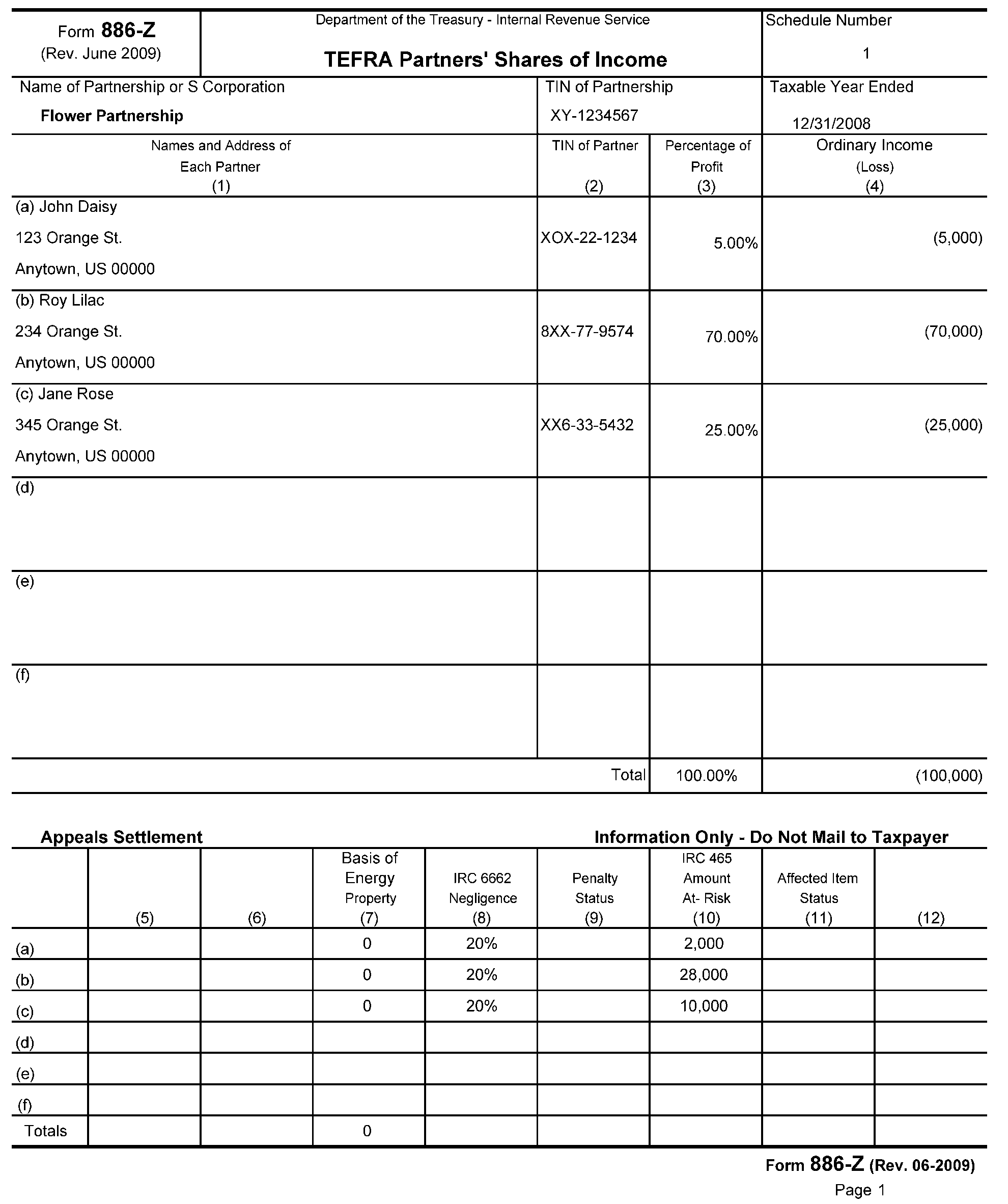
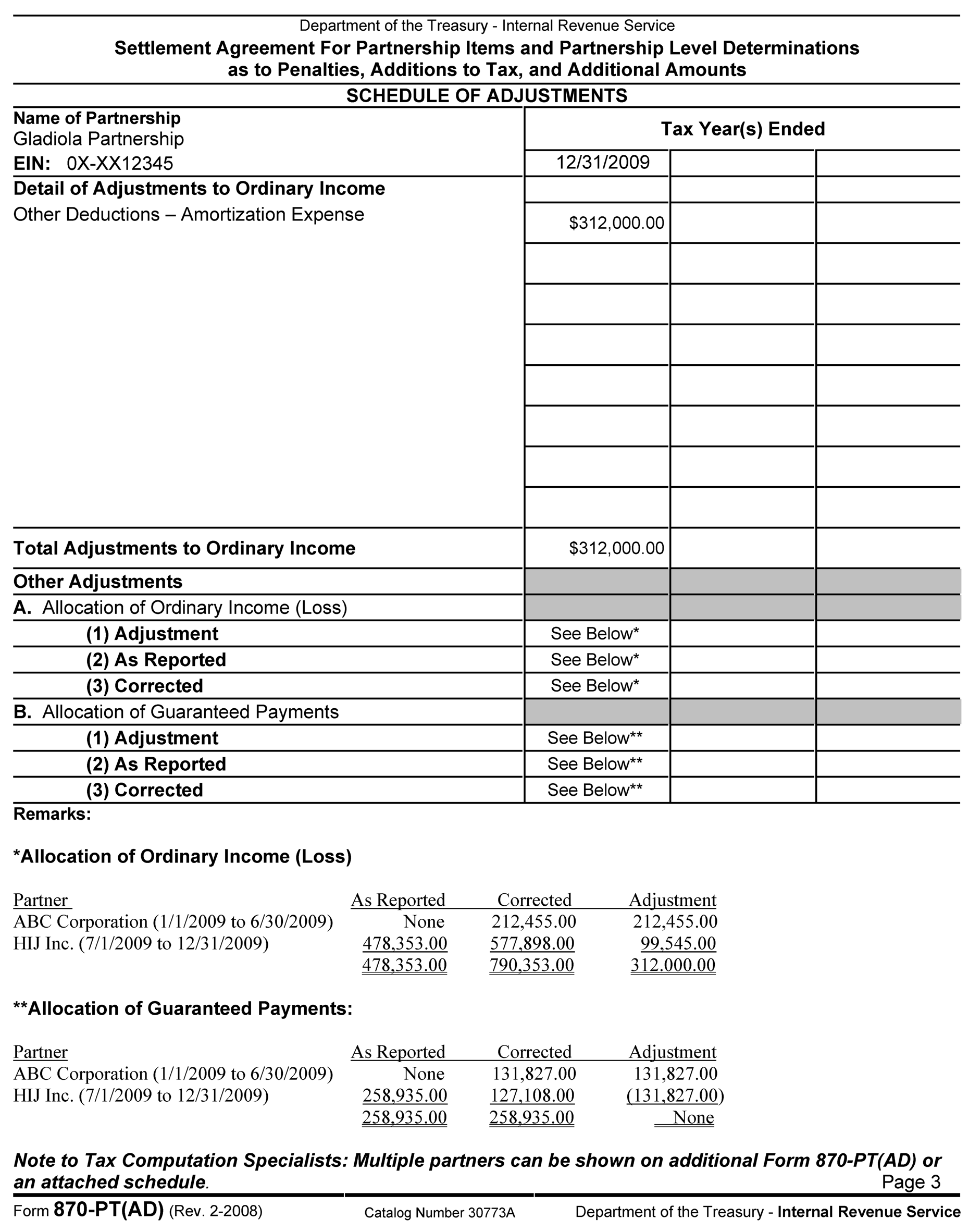
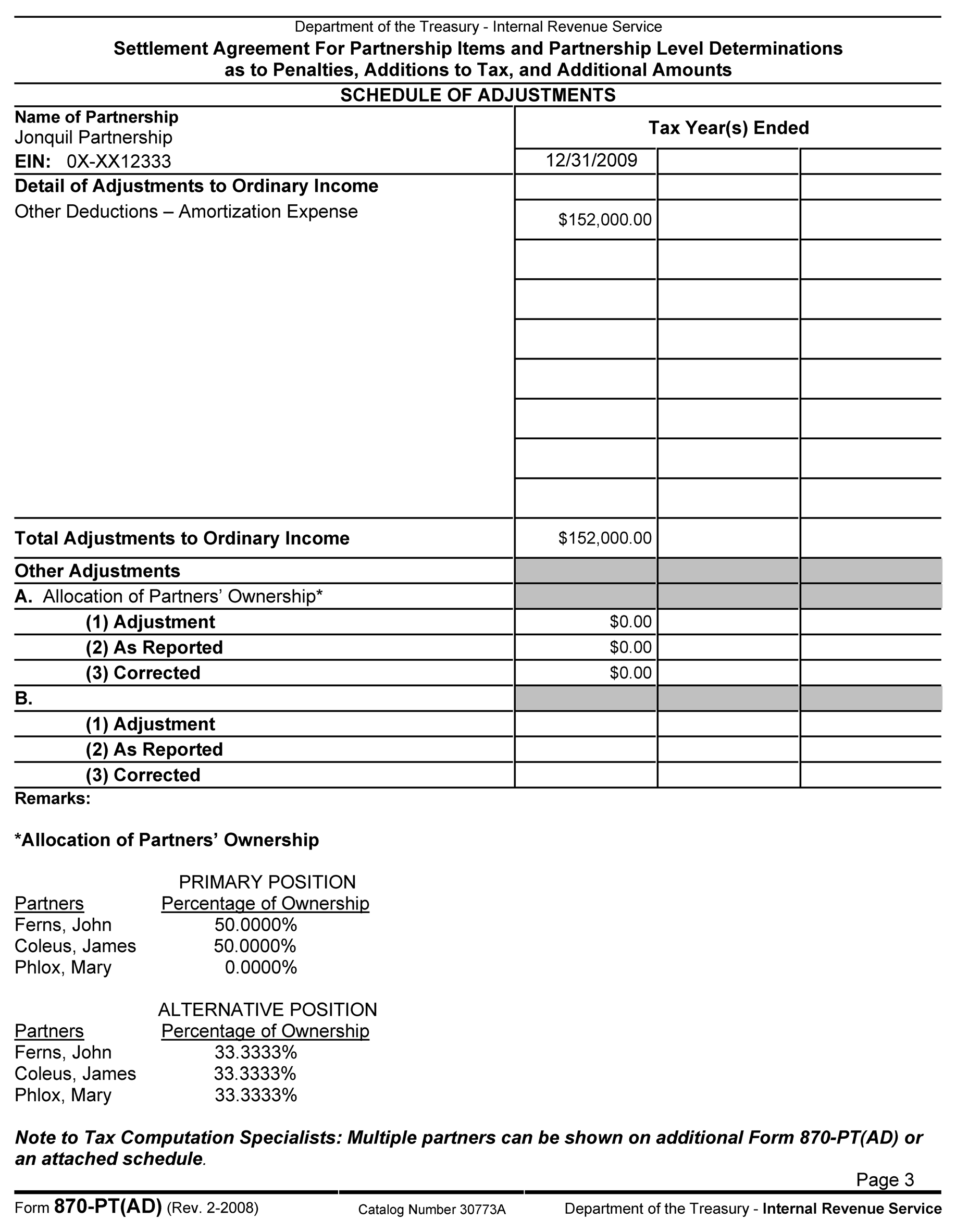
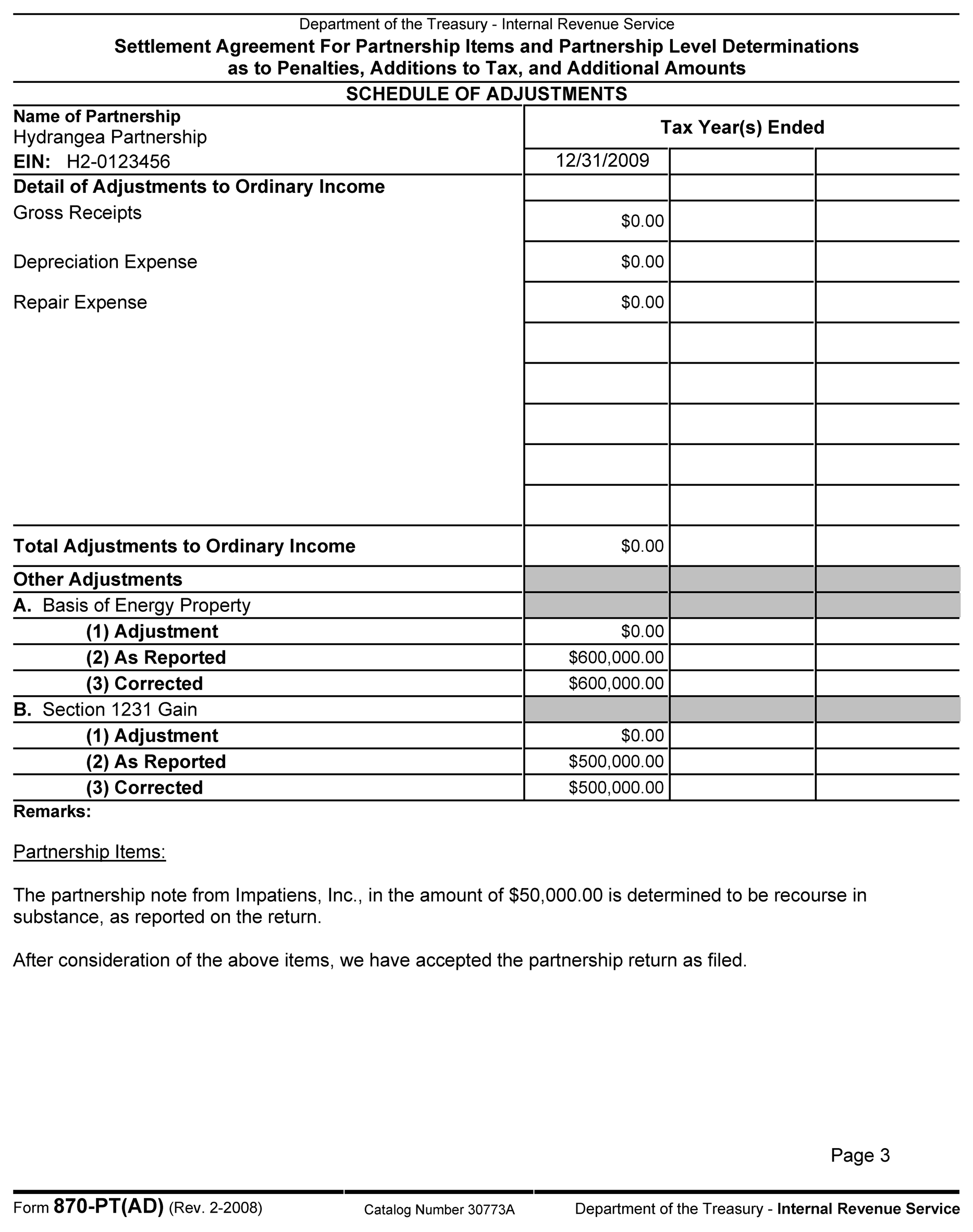

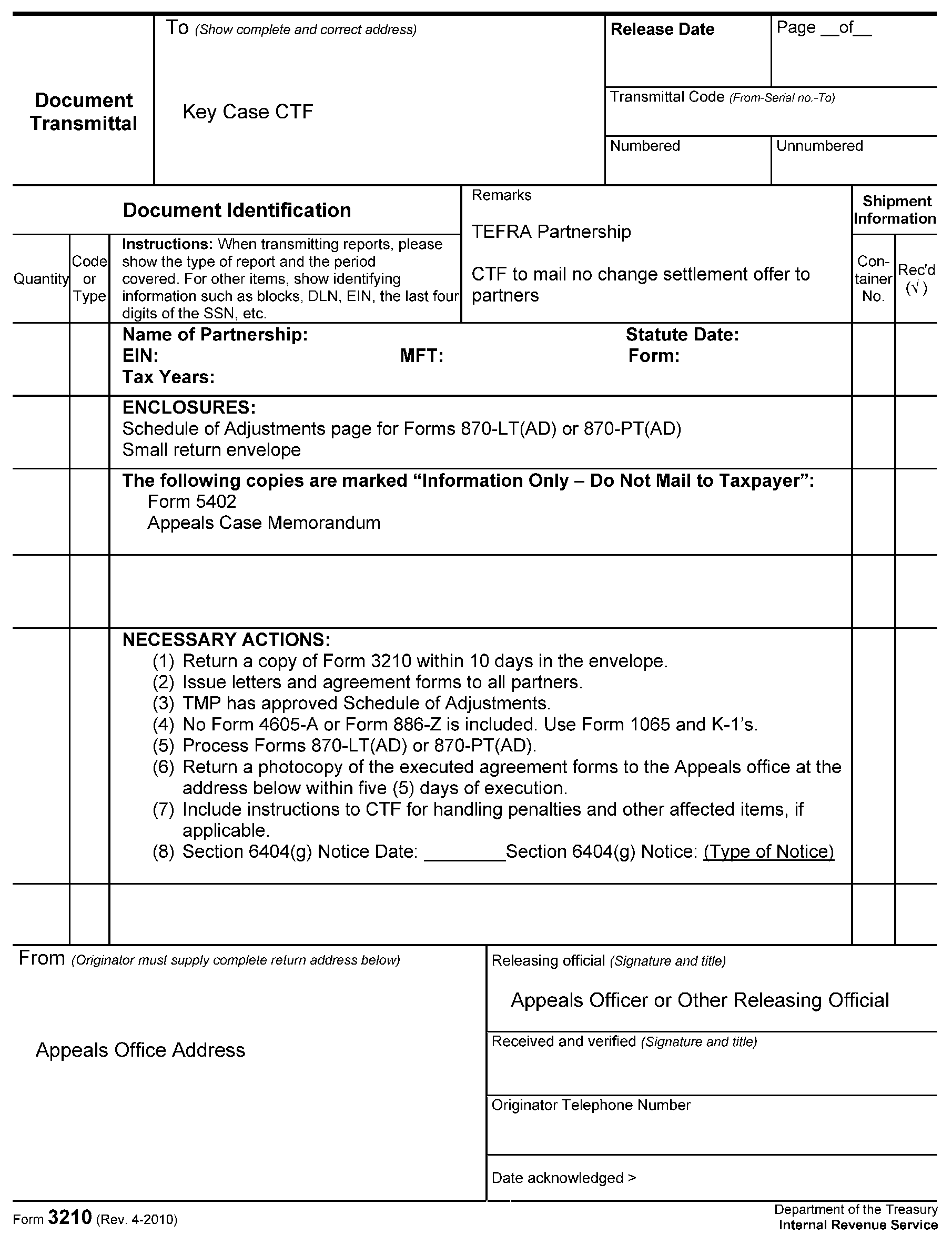
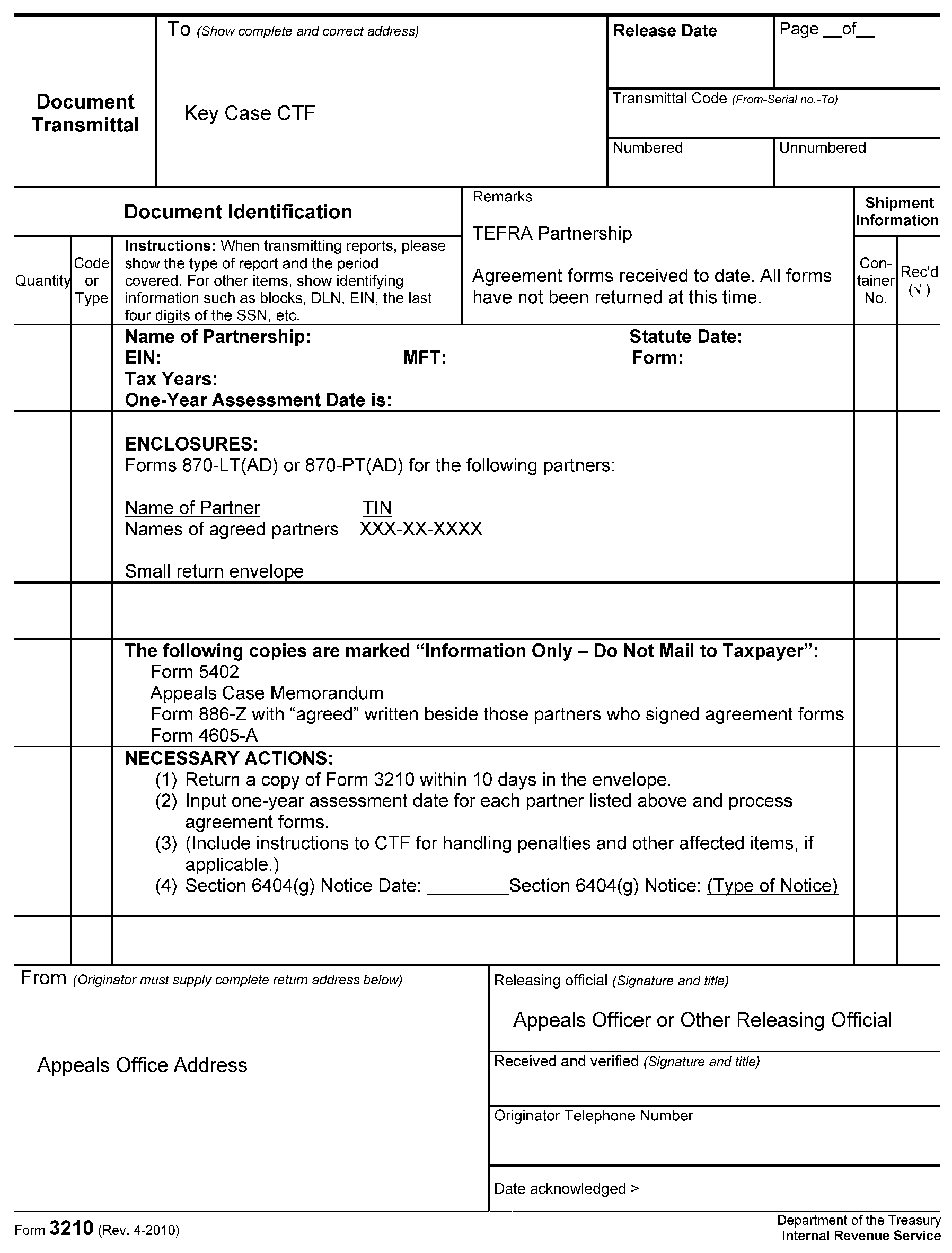
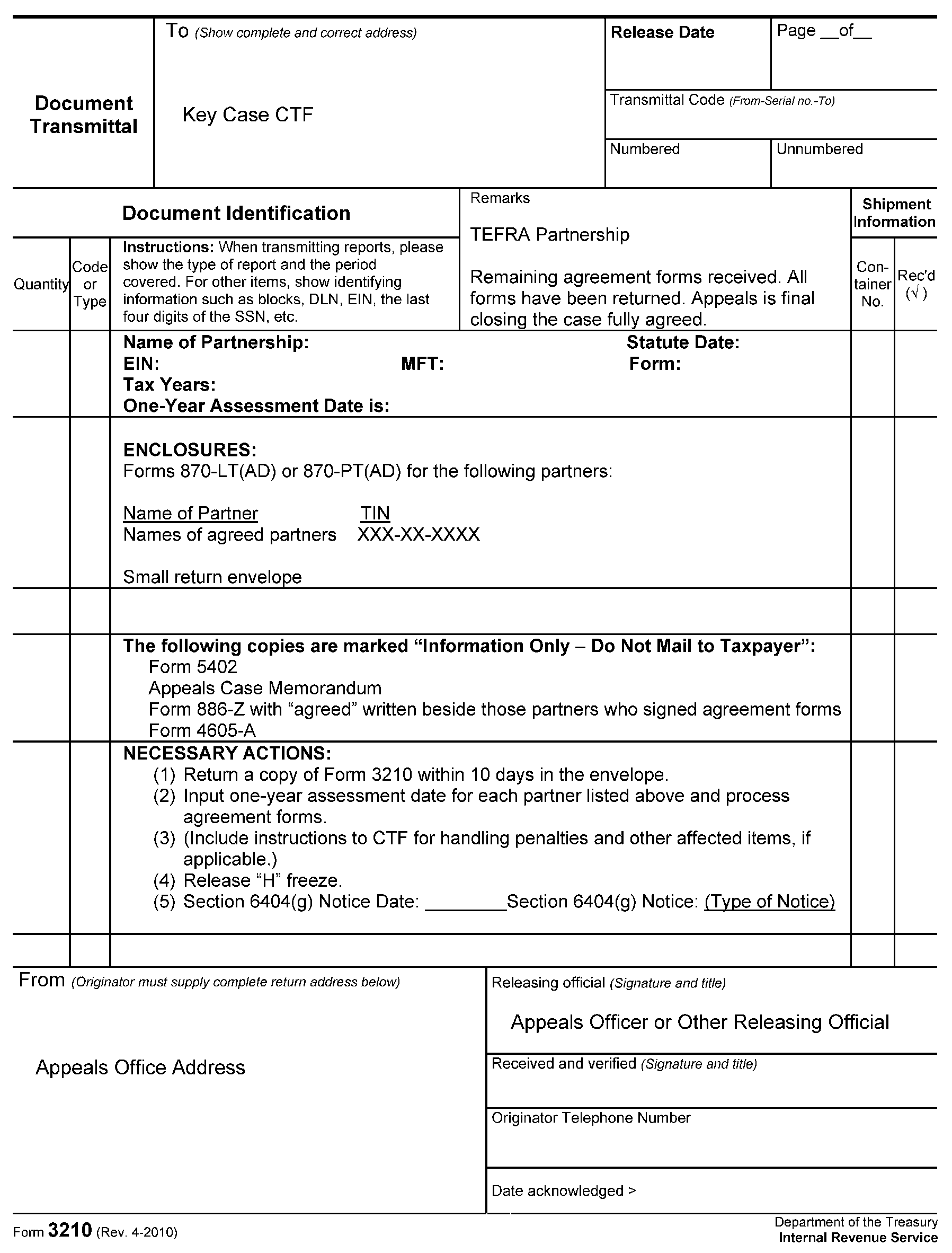
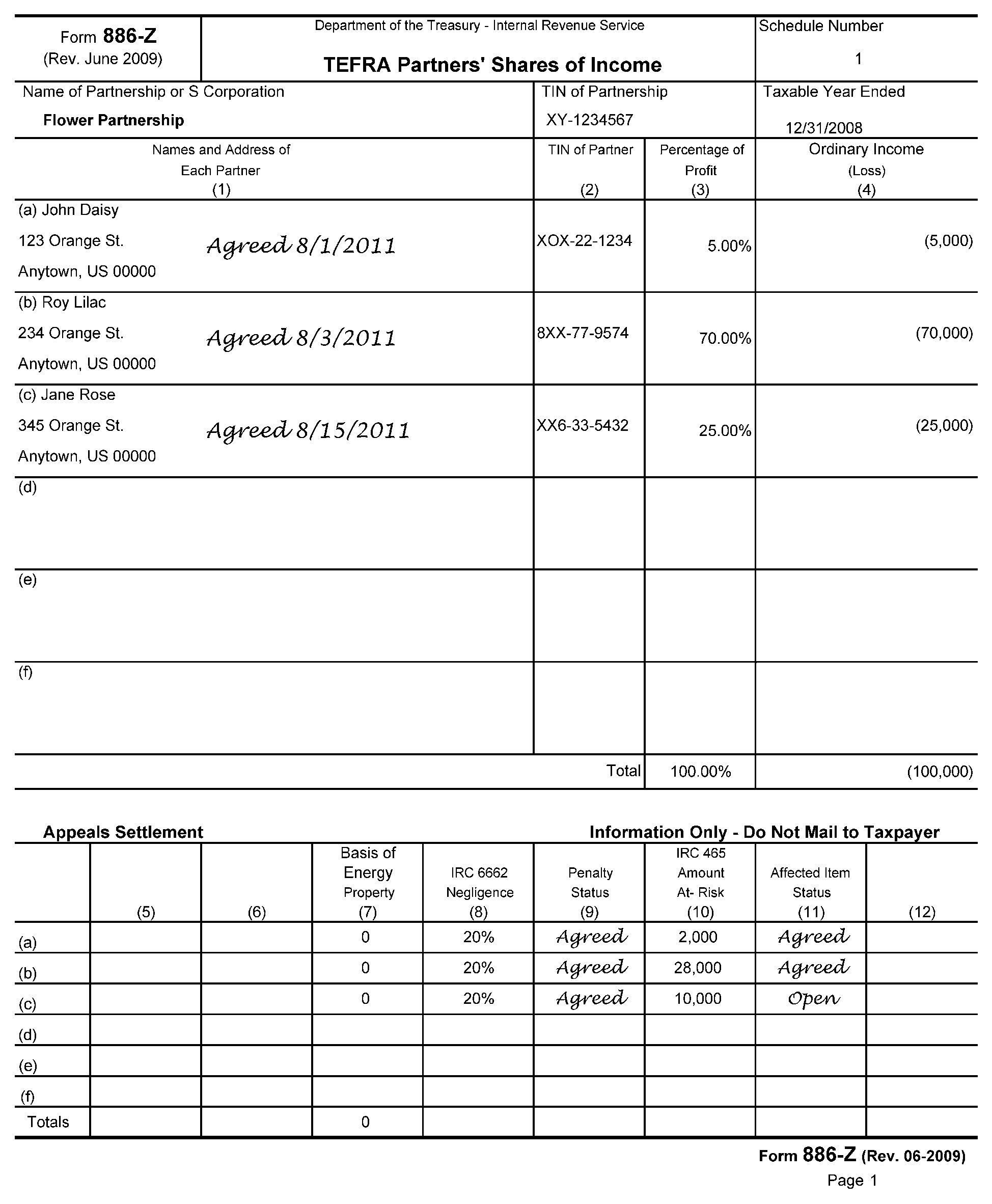
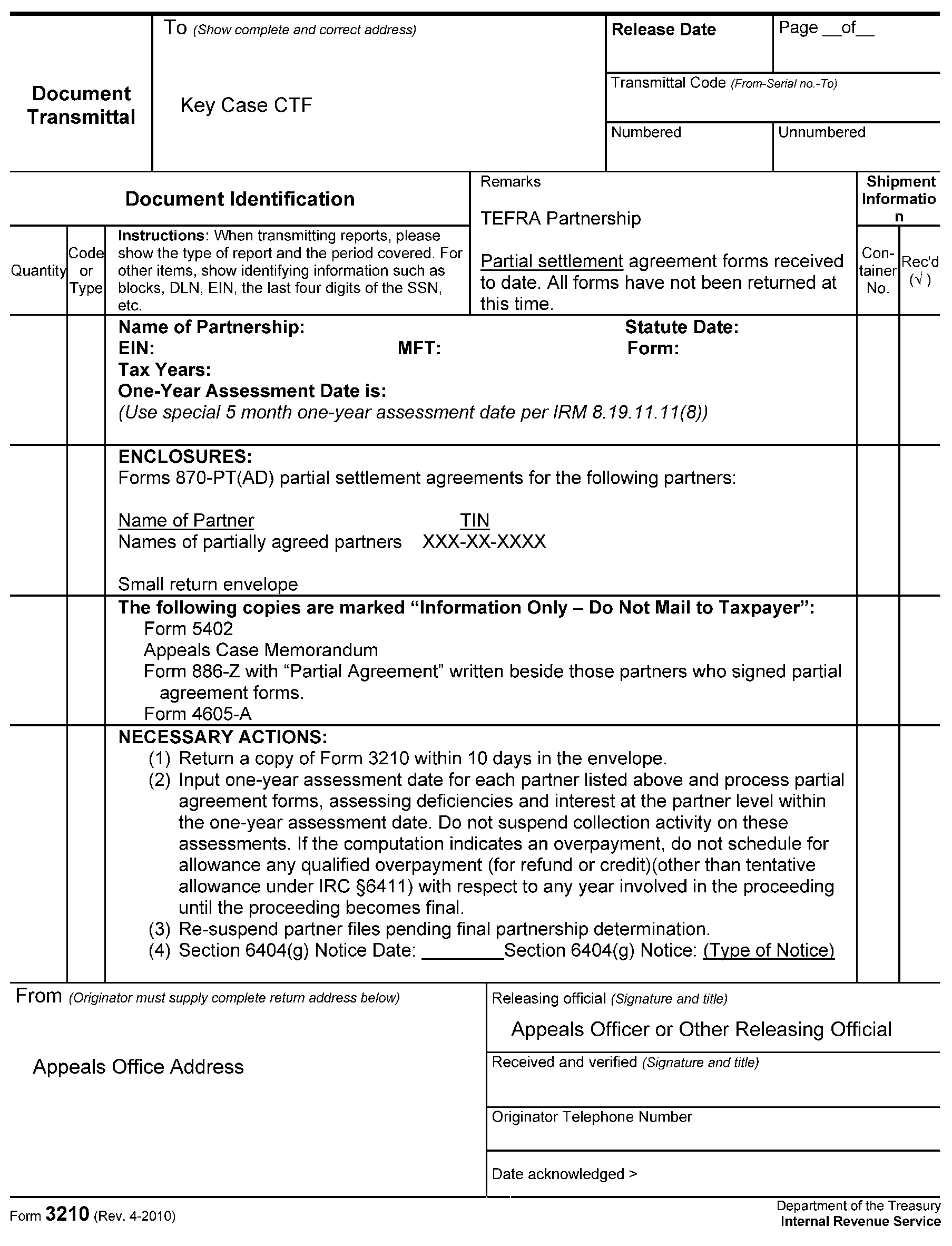
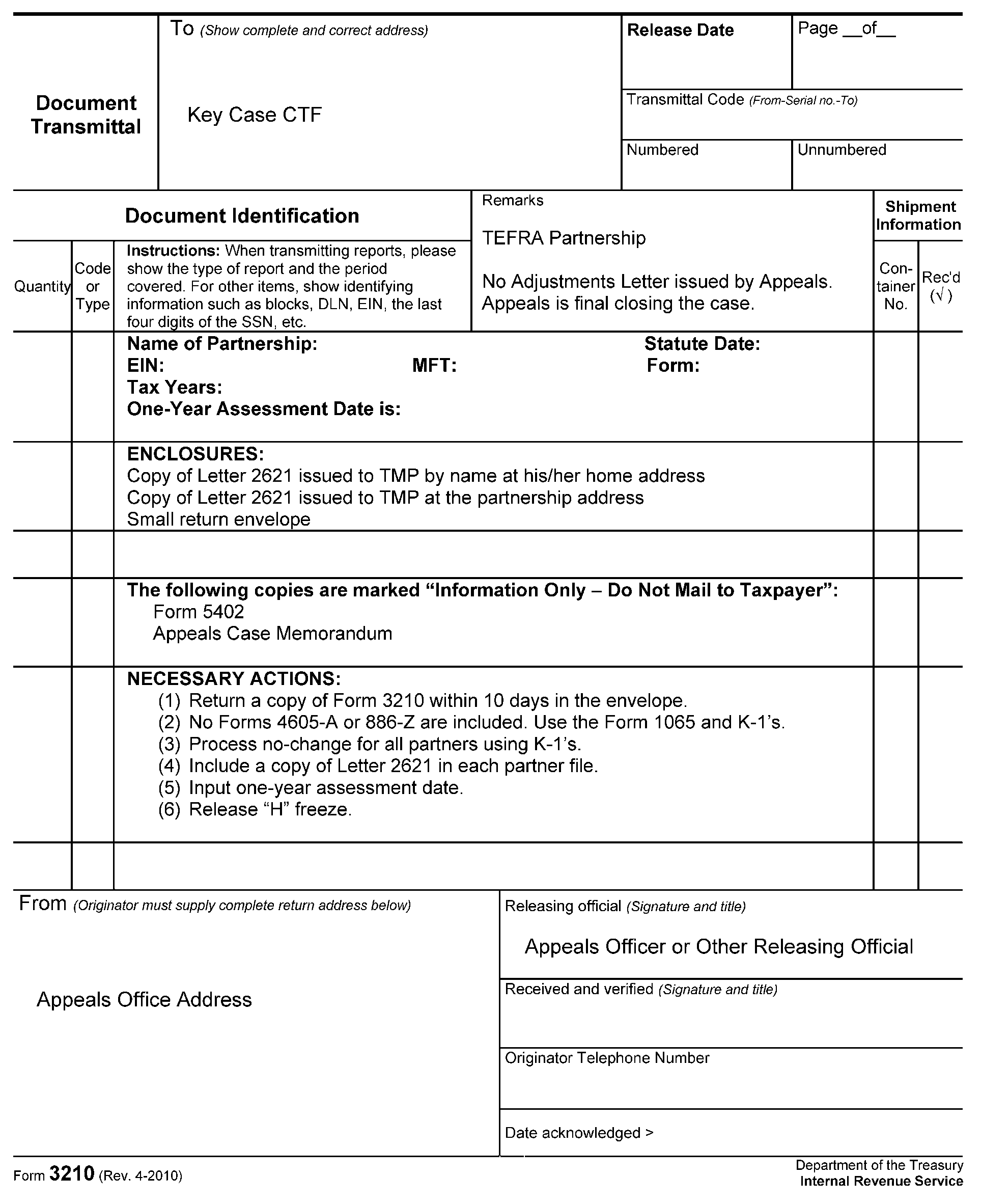

 )
or https:// means you've safely connected to the .gov website. Share sensitive information only on official, secure websites.
)
or https:// means you've safely connected to the .gov website. Share sensitive information only on official, secure websites.

